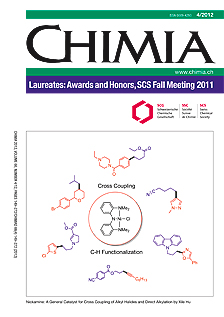Exploring Forces between Individual Colloidal Particles with the Atomic Force Microscope
DOI:
https://doi.org/10.2533/chimia.2012.214Keywords:
Atomic force microscope, Colloidal probe technique, Dlvo theory, Double-layer forces, Van der waals forcesAbstract
Forces between individual colloidal particles can be measured with the atomic force microscope (AFM), and this technique permits the study of interactions between surfaces across aqueous solutions in great detail. The most relevant forces are described by the Derjaguin, Landau, Verwey, and Overbeek (DLVO) theory, and they include electrostatic double-layer and van der Waals forces. In symmetric systems, the electrostatic forces are repulsive and depend strongly on the type and concentration of the salts present, while van der Waals forces are always attractive. In asymmetric systems, the electrostatic force can become attractive as well, even when involving neutral surfaces, while in rare situations van der Waals forces can become repulsive too. The enormous sensitivity of the double layer forces on additives present is illustrated with oppositely charged polyelectrolytes, which may induce attractions or repulsions depending on their concentrations.Downloads
Published
2012-04-25
Issue
Section
Scientific Articles
License
Copyright (c) 2012 Swiss Chemical Society

This work is licensed under a Creative Commons Attribution-NonCommercial 4.0 International License.
How to Cite
[1]
P. Sinha, I. Popa, M. Finessi, F. J. Ruiz-Cabello, I. Szilágyi, P. Maroni, M. Borkovec, Chimia 2012, 66, 214, DOI: 10.2533/chimia.2012.214.







